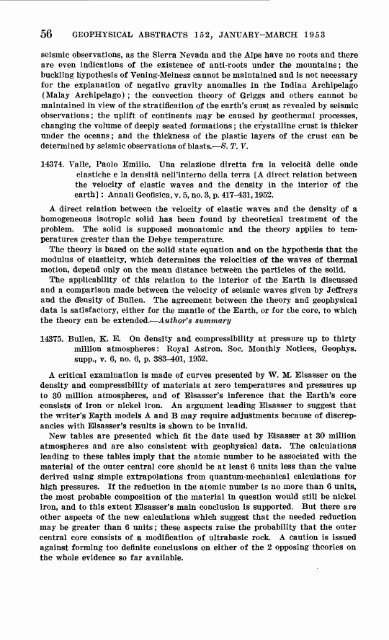Geophysical Abstracts 152 January-March 1953
Geophysical Abstracts 152 January-March 1953
Geophysical Abstracts 152 January-March 1953
You also want an ePaper? Increase the reach of your titles
YUMPU automatically turns print PDFs into web optimized ePapers that Google loves.
56 GEOPHYSICAL ABSTRACTS <strong>152</strong>, JANUARY-MARCH <strong>1953</strong><br />
seismic observations, as the Sierra Nevada and the Alps have no roots and there<br />
are even indications of the existence of anti-roots under the mountains; the<br />
buckling hypothesis of Vening-Meinesz cannot be maintained and is not necessary<br />
for the explanation of negative gravity anomalies in the Indian Archipelago<br />
(Malay Archipelago) ; the convection theory of Griggs and others cannot be<br />
maintained in view of the stratification of the earth's crust as revealed by seismic<br />
observations; the uplift of continents may be caused by geothermal processes,<br />
changing the volume of deeply seated formations; the crystalline crust is thicker<br />
under the oceans; and the thickness of the plastic layers of the crust can be<br />
determined by seismic observations of blasts. 8. T. V.<br />
14374. Valle, Paolo Emilio. Una relazione diretta fra la velocita delle onde<br />
elastiche e la densita nell'interno della terra [A direct relation between<br />
the velocity of elastic waves and the density in the interior of the<br />
earth] : Annali Geofisica, v. 5, no. 3, p. 417-431,1952.<br />
A direct relation between the velocity of elastic waves and the density of a<br />
homogeneous isotropic solid has been found by theoretical treatment of the<br />
problem. The solid is supposed monoatomic and the theory applies to tem<br />
peratures greater than the Debye temperature.<br />
The theory is based on the solid state equation and on the hypothesis that the<br />
modulus of elasticity, which determines the velocities of the waves of thermal<br />
motion, depend only on the mean distance between the particles of the solid.<br />
The applicability of this relation to the interior of the Earth is discussed<br />
and a comparison made between the velocity of seismic waves given by Jeffreys<br />
and the density of Bullen. The agreement between the theory and geophysical<br />
data is satisfactory, either for the mantle of the Earth, or for the core, to which<br />
the theory can be extended. Author's summary<br />
14375. Bullen, K. E. On density and compressibility at pressure up to thirty<br />
million atmospheres: Royal Astron. Soc. Monthly Notices, Geophys.<br />
supp., v. 6, no. 6, p. 383-401, 1952.<br />
A critical examination is made of curves presented by W. M. Elsasser on the<br />
density and compressibility of materials at zero temperatures and pressures up<br />
to 30 million atmospheres, and of Elsasser's inference that the Earth's core<br />
consists of iron or nickel iron. An argument leading Elsasser to suggest that<br />
the writer's Earth models A and B may require adjustments because of discrep<br />
ancies with Elsasser's results is shown to be invalid.<br />
New tables are presented which fit the date used by Elsasser at 30 million<br />
atmospheres and are also consistent with geophysical data. The calculations<br />
leading to these tables imply that the atomic number to be associated with the<br />
material of the outer central core should be at least 6 units less than the value<br />
derived using simple extrapolations from quantum-mechanical calculations for<br />
high pressures. If the reduction in the atomic number is no more than 6 units,<br />
the most probable composition of the material in question would still be nickel<br />
iron, and to this extent Elsasser's main conclusion is supported. But there are<br />
other aspects of the new calculations which suggest that the needed reduction<br />
may be greater than 6 units; these aspects raise the probability that the outer<br />
central core consists of a modification of ultrabasic rock. A caution is issued<br />
against forming too definite conclusions on either of the 2 opposing theories on<br />
the whole evidence so far available.

















